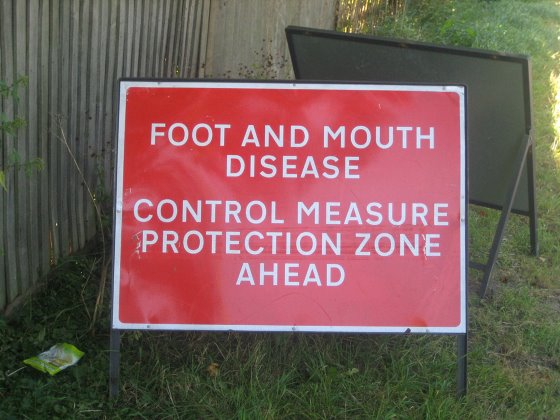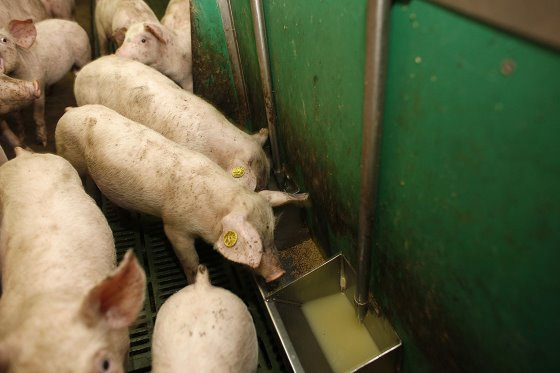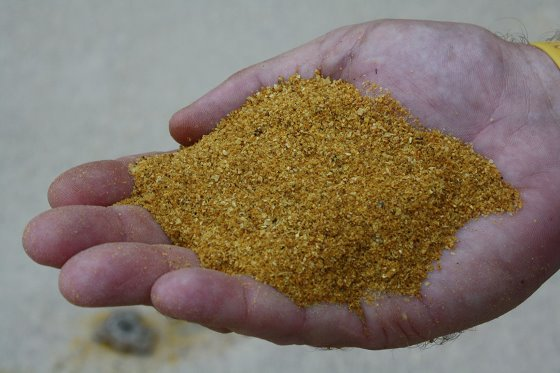来源:Pig Progress
With the ongoing spread of African Swine Fever in China, the use of swill has been identified as a culprit. No matter how important it is to pay more attention to food and feed safety, it is also wise to remind ourselves of how to produce sustainably as well, writes Pig Progress editor Vincent ter Beek.
随着非洲猪瘟在中国持续蔓延,泔水的使用已被确定为罪魁祸首。Pig Progress的编辑Vincent ter Beek写道,无论关注食品和饲料安全有多么重要,提醒自己如何以可持续的方式生产也是明智之举。
Kitchen waste, according to the Chinese authorities, has been one of the major causes for the spread of African Swine Fever through China. For that reason, the authorities have banned its use for feeding to pigs.
据中国当局称,厨余垃圾是非洲猪瘟在中国传播的主要原因之一。因此,当局已禁止将其用于生猪喂养。

In doing so, the Chinese are rapidly learning a lesson that the British learnt the hard way 2 decades ago. In 2001, the country spent £8 billion (€ 9 billion) to get rid of the aftermath of the Foot-and-Mouth Disease (FMD) outbreaks which cost the lives of millions of sheep and cattle. “The epidemic was probably caused” – I’m quoting Wikipedia here – “by pigs which had been fed infected rubbish that had not been properly heat-sterilised.”
这个过程,中国迅速吸取了英国人近20年前的惨痛教训。2001年,英国花费了80亿英镑(90亿欧元)来解决口蹄疫(FMD)爆发带来的后果,数百万头绵羊和牛死于这场疾病。“这种流行病可能是由食用了未经恰当加热消毒的厨余垃圾的生猪引起的” ——引自维基百科。
The danger of feeding swill to animals
喂食泔水的危害
The severity of that lesson can be seen on a daily basis at social media. Especially in areas where African Swine Fever has not emerged, i.e. most countries in Western Europe, but also northern America, veterinarians, nutritionists and other agricultural experts leave no opportunity unused to warn for the danger of feeding swill to animals. After all, depending on the type of substrate it is on, ASF virus can live from several months up to several years even.
从社交媒体每日的更新可以得知这个教训有多么惨重。在非洲猪瘟尚未爆发的地区尤为显著,例如大多数西欧国家,以及北美。兽医、营养师以及其它农业专家抓住一切机会警告行业喂食泔水的危害。毕竟,根据其所在基质的类型,非洲猪瘟病毒可以存活数月甚至数年。
Make no mistake – I do perfectly understand the ‘why’ behind each of their words as the fate of an entire industry is at stake. Yet there’s something else that needs attention.
毫无疑问,我非常理解他们每一个用词背后的原因,因为整个行业的命运危在旦夕。但还有其它需要注意的地方。
Vision for the future of agriculture
对未来农业的愿景
For that, follow me to my country the Netherlands. This September, the Ministry of Agriculture, Nature and Food Quality launched a ‘vision’ for the future (all in Dutch, I’m afraid). No policy document yet, but a package of ideas where the country will likely have to go.
Key to this vision is the concept of a circular economy, with words like ‘local’ and ‘re-use’ being common. The thought is that the Netherlands should become a leader in circular economy, and should have an agriculture that can do without synthetic fertilisers, which will not erode the soil and will take care of both biodiversity as well as animal welfare. It has been received with a mixture of opinions – from praise to heavy criticism.
今年9月,荷兰农业、自然和食品质量部为发起了一个“未来愿景”。目前还没有正式政策文件,但有一系列荷兰可能将落地的想法。这个愿景的关键是“循环经济”,其中多次出现“本地”和“循环利用”这样的词。我们的想法是,荷兰应该成为循环经济的领导者,这里的农业不应该使用合成肥料,不腐蚀土壤,同时兼顾生物多样性和动物福利。目前收到了各种意见,既有赞美也有批评。
On the closing of the circular production chains, the Netherlands agricultural minister Carola Schouten said: “[This should happen] within a farm, a region, the Netherlands or even within international trade. The motto should be: arrange things locally if it can be done locally, arrange things regionally or internationally if you have to. Leftovers from the agricultural sector and the food chains have to be re-used or re-processed to new products.”
对于循环经济生产链的最后一环,荷兰农业部长Carola Schouten说:“这应该在农场内、地区中、荷兰境内甚至国际贸易中。我们的座右铭应该是:如果可以在当地进行,则在当地解决,必要的时候,可以在区域或国际范围内解决。农业生产和食物链的残余物必须重新使用或重新加工成新产品”。
The circular economy and animal husbandry
循环经济与畜牧业
What that all means for animal husbandry? It means that feed should come increasingly from own soil or at least from areas close by. By-products from other sectors will come back as animal feed. The emission of greenhouse gases, dust particles, odour and ammonia will have to come down further; animal welfare and animal health will get a stronger priority. The exact roll-out of the circular economy will determine how many animals exactly can be kept.
这一切对畜牧业意味着什么?这意味着越来越多的饲料来自本土或至少是附近地区。其他产业的副产品将作为动物饲料回收利用。未来温室气体、尘埃颗粒、气味和氨气的排放将进一步减少,动物福利和动物健康将更受重视。循环经济的确切推出将决定畜牧业的饲养规模。

Especially the phrase ‘leftovers from the agricultural sector and the food chains’ is intriguing. Far from this being a call to immediately start re-using swill as feed, it is an attempt by the Dutch authorities to start thinking more and better how (industrial) left-overs can be used more cleverly. And bear in mind that this call happened in an advanced industry where there is already a great deal of re-use of by-products.
“农业生产和食物链的残余物”一说尤其有趣。这不是呼吁立即开始重新使用泔水作为饲料,而是荷兰当局开始就如何更巧妙地使用(行业)剩余物进行思考。请记住,这一呼吁发生在一个已经大量重复使用副产品的先进行业。
Important message for swine producers
给生猪生产者的重要信息
I think the vision holds an important message for agricultural experts and swine producers all over the planet. In an attempt to provide more food for all people, intensive livestock production has been encouraged everywhere over the last few decades. As countries and consumers grew richer, not only food security issues but also food safety and even food quality issues have become important.
我认为这一愿景为全球农业专家和养猪生产者提供了重要信息。为了向人类提供更多食物,过去几十年来,全球各地都在鼓励集约化畜牧生产。但随着国家和消费者越来越富裕,不仅粮食安全问题,食品安全及食品质量问题也显得越来越重要。

For professional livestock farms all over the world, this means that the majority of animal nutrition is being produced in feed mills, using ingredients often specifically grown or produced for consumption by livestock. A controlled process, in which each step is controlled and each introduction of bad substances is excluded as much as possible – from mycotoxins to bacteria or viruses.
对于世界各地的专业畜牧场而言,这意味着大部分动物营养都是在饲料厂生产的,使用的通常是专门为牲畜而种植或生产的原料。这是一个受控制的过程,其中每个步骤都受到控制,并且尽可能排除每种不良物质的引入,包括霉菌毒素、细菌和病毒。
Worlds need to come together
各国各行应团结起来
In the message of the Netherlands ministry, I hear that that world needs to come together with that of other industries, including that of waste management. If we want to be thinking of a more sustainable way of producing, we can simply not ignore the variety of leftovers, by-products and even waste that is becoming available every year.
在荷兰相关部门的信息中,我了解到世界各国各个行业应联合起来,包括废物管理。如果想要实现一种更加可持续的生产方式,我们就不能忽视每年产生的剩余物、副产品甚至废物的种类之繁多。
Making the re-use process reliable, flawless and in line with the high demands of modern-day swine farmers, feed mills, retail stores, critical consumers as well as political institutions in my view, may seem like a huge challenge – yet it is one we need to address. When possible, it needs to happen to produce more sustainably in the future.
在我看来,如何使重复使用过程可靠、完美,并符合现代养猪场、饲料厂、零售商、严格的消费者以及政府机构的高要求,可能看起来是一个巨大的挑战 - 但却是我们需要解决的问题。实现的话,未来生产将更具可持续性。
A new taboo on ingredients?
原料新禁忌?
What I am worried about, however, is that this thought process is slowed down substantially, as a result of African Swine Fever. Now everybody is being so concerned about using swill as feed, I’m quite afraid that the broader, contextual thinking about re-use of ingredients in general is also receiving that label of ‘taboo’.
不过我担心的是,由于非洲猪瘟的影响,这一进程大幅放缓。现在每个人都很忌讳用泔水作为饲料原料,人们联想起来,原料再利用可能会被打上“禁用”的标签。
I can imagine being extremely careful about ingredients is the right thing for the swine business on the short term. But please, let’s just not forget thinking about the longer term as well.
我可以想象,对于养猪业而言,在短期内谨慎地选用原料是对的。但是,请不要忘了从长远考虑问题。
(文/爱猪网记者刘坤颖编译,爱猪网原创请勿转载)










